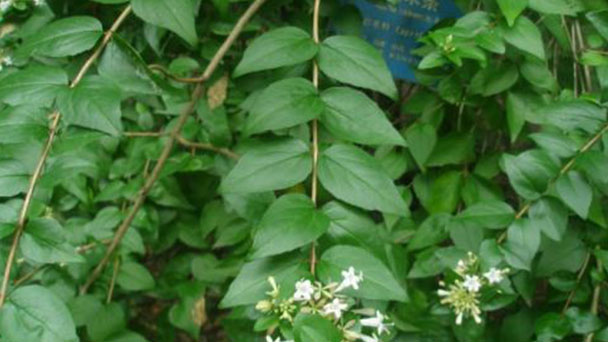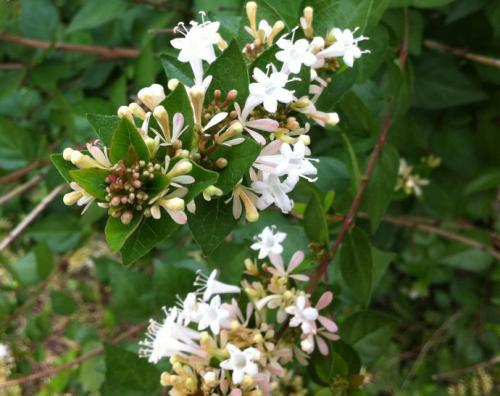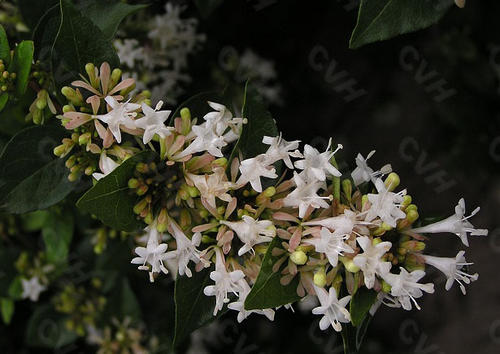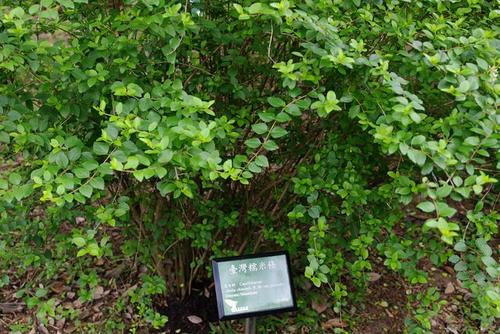Chinese abelia (Abelia chinensis) profile
Written by Maggie
Mar 22 2021

Chinese abelia (Abelia chinensis), also called Abelia chinensis and Abelia rupestris, is a family of honeysuckle and a genus of six trees. Young branchlets are reddish brown, branchlets derm lacerate. Leaves are ovate or ovate-elliptic, opposite, margin sparsely shallowly dentate, base of midvein of dorsal leaf densely pilose. Cymes are terminal or axillary, pollen red or white, fragrant, calyx pubescent, 5-lobed, ca. 5 mm, corolla funnel-shaped, rows pubescent, stamens 4, corolla projecting. Achene is about 5 mm long, the top has 5 calyx lobes. Chinese abelia like warm and humid climates and have poor cold tolerance. Planted in northern areas, branches are vulnerable to frost damage.
Chinese abelia picture

Chinese abelia info
| Botanical Name | Abelia chinensis |
| Common Names | Chinese abelia,Abelia chinensis and Abelia rupestris |
| Plant Type | Deciduous shrub |
| Sun | Full sun to part shade |
| Hardiness Zones | 7 to 9 |
| Flower color | White |
| Native Area | China |
| Mature size | 5.00 to 8.00 feet high, 3.00 to 5.00 feet wide |
Morphological characteristics of Chinese abelia
Stems
Chinese abelia is a deciduous, branching shrub, up to 2 m tall; Branches are slender, reddish-brown, pubescent, branches of longitudinal bark split. Leaves sometimes are three whorled, oblong-ovate to elliptic ovate-ovate, apically acute or long acuminate, base rounded or cordate, 2-5 cm long, 1-3.5 cm wide, margin sparsely circular serrate, sparsely pubescent at first above, base main veins and lateral veins densely white pubescent below, upper leaves of flower branches tapered upward.
Leaf
Thin left much branched shrubs of Chinese abelia, up to 2m tall. The young branches are hairy, reddish brown, the bark of the old branches is longitudinal cracked. Leaves are opposite, sometimes 3 whorled; Petiole is 1 -- 5mm long; Leaf blade is oblong-ovate to elliptically ovate, 2 -- 5cm long, 1 -- 3.5cm wide, apex acute or shortly acuminate, base rounded or cordatate, margin sparsely round serrate, sparsely short hairs above, base densely pubescent along midvein and lateral veins below.
Flowers
Chinese abelia is a cyme in the upper leaf axils of branchlets and consists of many inflorescences assembled into a panicle cluster; Pedicel is pubescent, fruIt 'smoothie; Flowers are aromatic, with 3 pairs of bracteoles; Calyx tube is cylindrical, pubescent, slightly oblate, longitudinally striate, calyx leaves 5-lobed, lobes elliptic or ovate-oblong, ca. 5mm long, fruit curved red; Corolla is white to pink, funnelform, 1 -- 1, 2cm long, puberulent, lobes 5, oval ovate; chinese abelia has 4 stamens, projecting corolla; Style is slender, stigma disc-shaped.
Fruit
Fruit of Chinese abelia ca. is 5mm, pubescent, crowned with persistent and slightly enlarged calyx lobes.
Ecological habits of Chinese abelia
Chinese abelia is common in mountains at altitudes of 170-1500 m; It is only grown in parks, gardens, botanical gardens and greenhouses north of Yangtze River.
Chinese abelia likes warm and humid climate and has poor cold tolerance. Planted in northern areas, branches are vulnerable to frost damage. Chinese abelia likes light and tolerant of shade .The soil condition is not strict, has certain adaptability, drought resistance, resistance to tumor thin ability is strong, the growth is vigorous, the root system is developed, the sprout sac, the germination force is strong.
The propagation of Chinese abelia
Chinese abelia usually uses sowing and cutting to propagate seedlings. The seeds are picked in the autumn after maturity, sand storage, the next spring sowing, sowing 30~40 days after the emergence of seedlings, cultivation for 1 year can be out of the nursery. Cuttage can be used in spring with hard branches, branches cut into 10~ L 5cm long cuttings, inserted in the sand bed, maintaining humidity, to give birth to the root system that is moved into the seedbed.
Summer can pick twigs, retain the upper pair of leaves, inserted in the full light fog slotting machine, maintain air humidity, 1 month or so that the root. Transplanting seedlings can be carried out after falling leaves or before germination. In order to keep seedlings growing vigorously, organic fertilizer is applied to the soil before cultivation, and the transplanted seedlings are pruned appropriately. Apply top dressing twice in each growing season, once in spring, and once in early summer before flowering. Water should be irrigated to keep the soil moist during the dry season. During the winter dormant period, the tree shape is adjusted and pruned according to the tree situation to maintain the renewal of the tree shape and branches.

Disease & pest control of Chinese abelia
Disease control
Leaf spot and powdery mildew are common hazards.
We can use 70% methyl tobujin wettable powder 1000 times liquid spray prevention and control.
Pest control
Insect insects have ruler moth and nymphal butterfly harm.
Spray 3000 times with 2.5% Enemy Kill Cream.
Distribution region of Chinese Abelia
Chinese abelia is widely distributed in provinces south of the Yangtze River in China, including Zhejiang, Jiangxi, Fujian, Taiwan, Hubei, Hunan, Guangdong, Guangxi, Sichuan, Guizhou and Yunnan.
Chinese abelia uses
Medical uses
Chinese abelia can treat heat clearing and detoxification; Cool the blood and stop the bleeding. Main damp-hot dysentery;7. a boil or lesion; Coughing up blood. Vomiting blood.Bloody; The flow of rocks;injuries
Ornamental value
Chinese abelia branches hang wan, tree appearance dancing, flowers when flowering dense tip, the color of white with red. It is suitable for planting in garden, pool side, roadside and wall corner, and can also be planted in groups as flower hedge and flower path. If in the evergreen forest edge embellishment, it is particularly pleasing to the eye.
The flowers of Chinese abelia are abundant and dense, with long flowering periods and red calyx lobes. It is a beautiful ornamental plant and often cultivated in the garden.
Application value
Chinese abelia is a secondary shrub with soft and pendant branches and swaying trees. When flowering, it has dense white flowers at the top, which are clean and lovely. It is suitable for planting in the pool, roadside, wall corner, lawn and underforest edge.

Latest Updated
- Benefits of Bugleweed - 7 Science-backed Health Benefits
- Bugleweed Dangers & Side Effects - Is It Poisonous?
- How to Plant Evergreen Trees - What You Should Know
- When to Plant Evergreens - Grow Guide for Evergreen Trees
- 12 Wonderful Evergreen Shrubs for Your Garden
- 12 Popular Evergreen Plants with Pictures for Beginners
- When And How To Prune A Lilac Bush Like a Pro
- How to Grow & Care for Lilac Vine (Hardenbergia Violacea)
- Japanese Lilac Tree (Syringa Reticulata) Care & Propagation Guide
- Shumard Oak Pros and Cons - What to Know
Popular Articles
- Winter maintenance of Antirrhinum Majus
- How to Grow Terminalia Mantaly Tree
- How to Grow and Care for Crossostephium Chinense
- How to grow Antirrhinum Majus in spring
- Peristeria Elata (Dove Orchid) Profile: Info & Care Guide
- Underwatered Snake Plant (Sansevieria Trifasciata) - Signs And How To Fix
- How to Care for Brazilian Jasmine Plant (Mandevilla Sanderi)
- How to Grow & Care for Graptopetalum Purple Delight in Summer
- Rosa Chinensis (China Rose): Plant Growing & Care Tips
- How to Care for Baby Sun Rose (Aptenia Cordifolia)